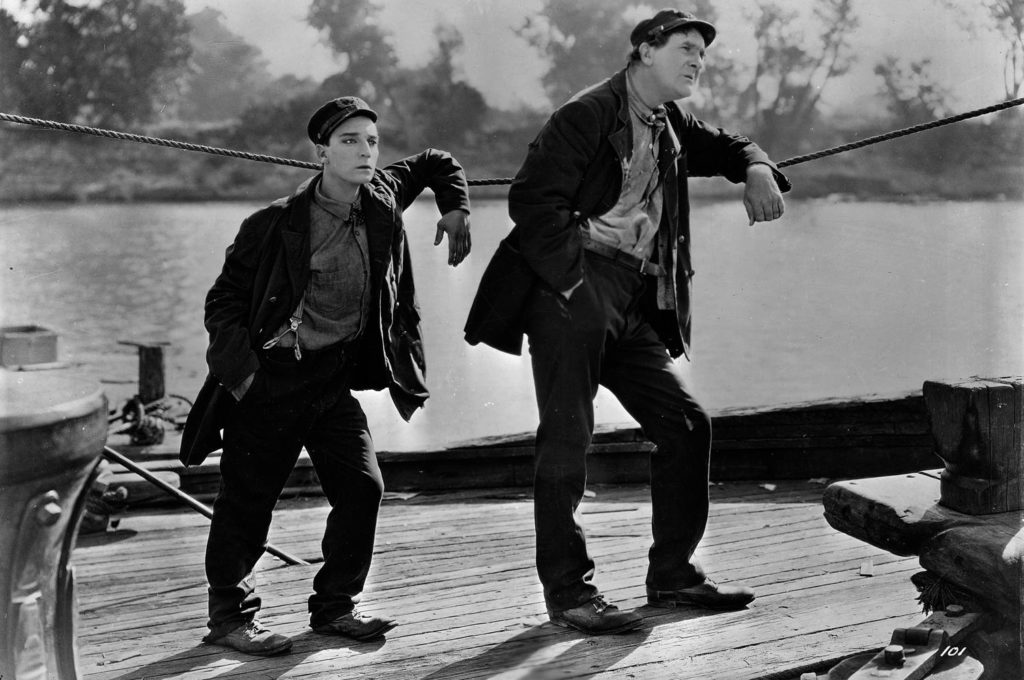Keaton Project

Programme curated by Cecilia Cenciarelli ed Elena Correra
In collaboration with Tim Lanza (Cohen Film Collection)
Restoration notes by Elena Tammaccaro
“Muddy Waters” – reads the first intertitle card in Steamboat Bill, Jr.: the camera pans from right to left – from the American river to the Sacramento River – through the vegetation of Discovery Park. This masterpiece has survived in several versions which look slightly different from this very first shot, confirming how enigmatic and elusive, Keaton’s oeuvre still is. Tracing back the film sources is not an easy task as not only are the camera angle and the length of the shots different, but so are the takes (as evidenced by the ‘hat trial’ business). The main element used for this restored version is a 35mm full frame safety duplicate negative struck by Raymond Rohauer in 1969 (presumably from a nitrate negative, now completely decomposed), and therefore a ‘lineal descendant’ of Keaton and Rohauer’s partnership.
With Neighbors, The Goat e Battling Butler we had the advantage of dealing with minor works – or at least of being considered such. However, by extracting them from a filmography packed with masterpieces, we now have the luxury of rediscovering them and being surprised by Keaton’s extraordinarily mature thinking on display and by his infallible and modern comic intuition. Although having two of the three original negatives available, the restoration of these films was rather problematic. Inspection took into account thirty-four elements, provided by the Cohen Film Collection, as well as by many other international film archives, including the Cinémathèque Royale de Belgique, the Library of Congress, the Filmoteca de Catalunya and the Cinémathèque de Toulouse. In order to reconstruct and restore the films, twenty different elements were compared and analyzed. Critical questions include: the inherent physical condition of the elements, their lack of photographic definition or their incompleteness (which posed ‘ethical’ questions); the editing of the credits (usually ‘retouched’ by Raymond Rohouer in order to control distribution and copyright); the presence of negative A and B; tinting issues.
Finally, we have decided to devote a short programme to Keaton’s first appearances on the small screen. Television allowed Keaton to re-emerge from professional darkness and contributed greatly to his newfound popularity, his artistic redemption on the sets of films by Wilder, Chaplin and Curtiz, and the retrospective celebrations of his career in the Seventies. In September 1949 “Life” magazine published a lengthy and authoritative article by James Agee celebrating the achievements of silent cinema and its forgotten masters. Three months later, in December, Keaton stepped into the studios of the extremely popular Ed Wynn Show. “By that time, I had lost all hope; I thought I’d never again have the opportunity to act”, Keaton recalled. In compiling this brief programme we decided not to show the many appearances in which Keaton was asked to simply ‘do Keaton’. Instead, we focused on cases in which his towering talent speaks loud and clear. Watching him in the role of the pettyl, myopic bureaucrat in The Awakening, based on Gogol’s The Overcoat, it is hard to believe that this was the first dramatic role of his career.
Cecilia Cenciarelli
Program
Thursday 29/06/2017
15:30
KEATON ON TV
KEATON ON TV
Kevin Brownlow e Cecilia Cenciarelli
Friday 30/06/2017
14:30
Cinema Lumiere - Sala Officinema/Mastroianni
Neighbors/The Goat
Neighbors/The Goat
Cecilia Cenciarelli e Tim Lanza
Gabriel Thibaudeau
Friday 30/06/2017
21:45
Piazza Maggiore
STEAMBOAT BILL, JR.
STEAMBOAT BILL, JR.
Cecilia Cenciarelli e Tim Lanza
Musiche eseguite dall’Orchestra del Teatro Comunale di Bologna, composte e dirette da Timothy Brock
Saturday 01/07/2017
14:30
Cinema Lumiere - Sala Officinema/Mastroianni
BATTLING BUTLER
BATTLING BUTLER
Cecilia Cenciarelli e Tim Lanza
Neil Brand
Saturday 01/07/2017
21:30
Cinema Lumiere - Sala Officinema/Mastroianni
NEIGHBORS/THE GOAT
NEIGHBORS/THE GOAT
Stephen Horne
Sunday 02/07/2017
16:00
Arlecchino Cinema
FESTA DEL CINEMA MUTO
FESTA DEL CINEMA MUTO
Daniele Furlati


